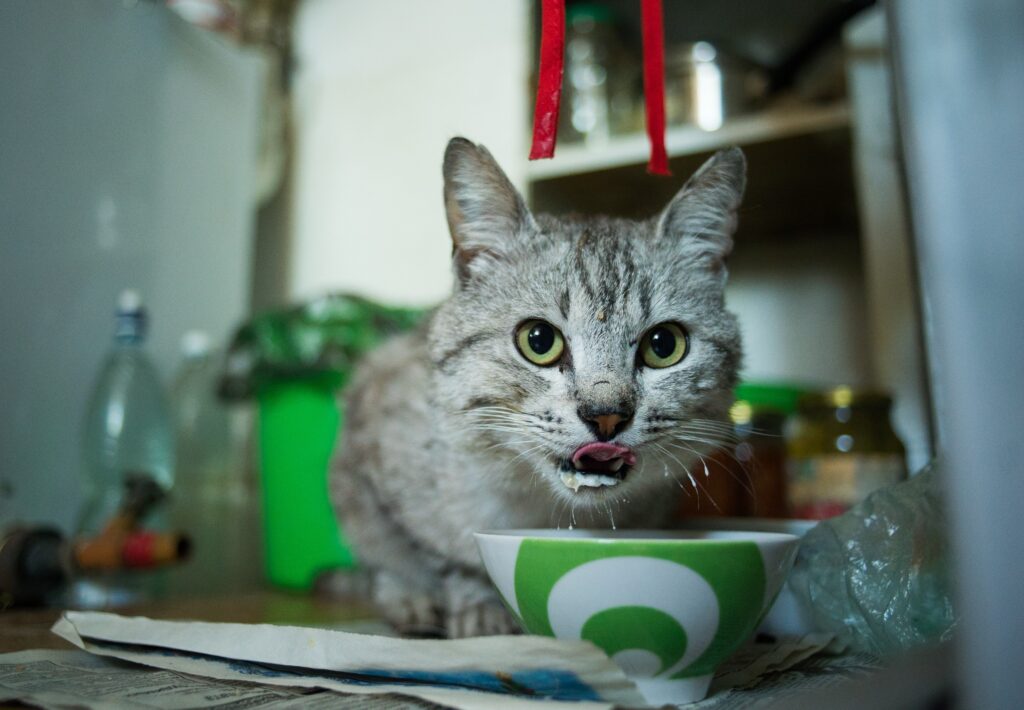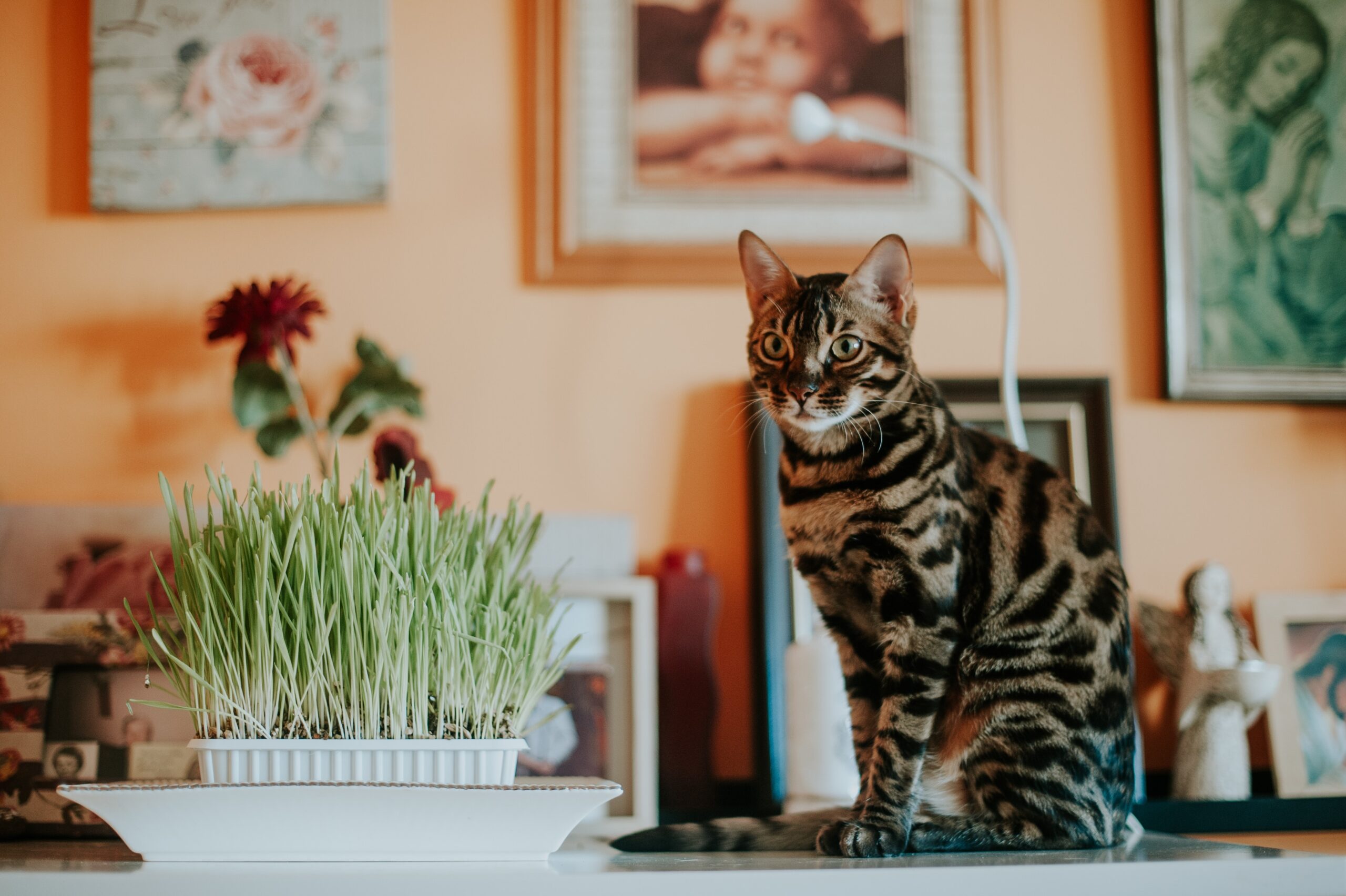While cats are obligate carnivores, there has been an increasing interest in incorporating plant-based foods into their diets. However, concerns arise regarding the consumption of wheat grass by cats.
Yes, cats can eat wheatgrass, and many cats enjoy doing so. Wheatgrass is a type of grass that is safe for cats and is often used as a dietary supplement or a form of enrichment. It is rich in fiber and can help with a cat’s digestion by providing roughage.
This article aims to explore the potential health benefits and nutritional value of wheat grass for feline companions. Additionally, it will discuss methods for introducing wheat grass to cats and address common concerns surrounding its consumption. Alternative options for cats with dietary restrictions will also be discussed, along with recipes and treats that incorporate wheat grass as a supplement.
Key Takeaways
- Wheat grass offers improved digestion and detoxification for cats.
- It is rich in vitamins, minerals, enzymes, and chlorophyll, which support overall health and vitality.
- Wheat grass provides important nutrients such as vitamins A, C, E, and K, as well as minerals like iron, magnesium, and calcium.
- However, it is important to introduce wheat grass gradually and monitor for potential allergic reactions or side effects.

Health Benefits of Wheat Grass for Cats
The health benefits of wheat grass for cats include improved digestion, detoxification, and increased nutrient absorption. Wheat grass is a young grass that belongs to the Triticum aestivum species. It is known for its high content of vitamins, minerals, enzymes, and chlorophyll. When introduced to a cat’s diet, wheat grass can help promote healthy digestion by aiding in breaking down food and preventing constipation. It also acts as a natural detoxifier by flushing out toxins from the body and supporting liver function. Additionally, wheat grass contains essential nutrients that are easily absorbed by cats, leading to improved overall health and vitality. These health benefits make wheat grass a valuable addition to a cat’s diet.
Nutritional Value of Wheat Grass for Cats
One potential benefit of including wheat grass in a feline’s diet is its nutritional value. Wheat grass is rich in essential vitamins, minerals, and antioxidants that can contribute to a cat’s overall health. It contains high levels of vitamins A, C, E, and K, which are important for immune function and eye health. Additionally, wheat grass provides minerals such as iron, magnesium, and calcium that support bone strength and muscle function.
The antioxidants found in wheat grass help combat free radicals in the body and reduce inflammation. To ensure optimal nutritional benefits, it is crucial to pay attention to the growing conditions of wheat grass. Cats should only consume organic wheat grass that has been grown in clean soil without the use of pesticides or chemicals to avoid any potential harm to their health.
How to Introduce Wheat Grass to Your Cat
Introducing wheat grass to a feline’s diet can be done gradually, allowing the cat to adjust to the taste and texture of this new addition. There are several ways to introduce wheat grass to picky eaters:
- Start by offering a small amount mixed with their regular food.
- Gradually increase the amount of wheat grass over time.
- Offer different forms of wheat grass, such as fresh or dried.
- Use treats or toys that contain wheat grass as an incentive.
- Observe your cat’s response and adjust accordingly.
In addition to being beneficial for picky eaters, there are also specific benefits of wheat grass for older cats. It can help improve digestion and alleviate constipation, provide essential nutrients like vitamins A and C, promote healthy weight management, support immune function, and reduce inflammation. However, it is important to consult with a veterinarian before introducing any new dietary changes or supplements to your cat’s routine.
Precautions When Feeding Wheat Grass to Cats
When feeding wheat grass to felines, it is important to consider potential precautions and risks. Some cats may have allergies to wheat grass, so it is crucial to monitor their reaction after ingestion. Signs of an allergic reaction can include vomiting, diarrhea, or skin irritations. If any of these symptoms occur, it is recommended to discontinue the use of wheat grass and consult a veterinarian for further guidance.
Additionally, there is a potential choking hazard with wheat grass ingestion. The long blades of grass can become tangled in a cat’s throat or gastrointestinal tract, leading to blockages or discomfort. To minimize this risk, it is advised to offer smaller portions of cut wheat grass or purchase commercially available cat-safe versions that are specifically designed for consumption. Considering these precautions will help ensure the safety and well-being of your feline companion.
Common Concerns About Cats Eating Wheat Grass
This discussion aims to explore the digestive benefits of wheat grass for cats and potential side effects. Wheat grass is often touted as a natural remedy for various digestive issues in cats, including hairball prevention and constipation relief. However, it is important to critically evaluate both the positive and negative aspects of feeding wheat grass to cats in order to make informed decisions about their dietary needs.
Digestive Benefits of Wheat Grass for Cats
The ingestion of wheat grass by cats has been found to provide various digestive benefits. Wheat grass is rich in fiber, which aids in digestion and helps prevent constipation. It also contains enzymes that can help break down proteins, fats, and carbohydrates, improving the overall digestion process. Additionally, wheat grass can assist in eliminating hairballs from a cat’s digestive system, reducing the discomfort associated with them.
Moreover, the chlorophyll present in wheat grass acts as a natural detoxifier for cats’ digestive systems, promoting overall wellness. However, it is essential to be aware of potential side effects that may arise from cats consuming wheat grass excessively or if they have specific sensitivities or allergies to it.
Transition: While there are notable benefits to feeding cats wheat grass for their digestion and overall wellness, it is crucial to understand the potential side effects that may occur.
Potential Side Effects
Excessive consumption or specific sensitivities to wheat grass may result in potential side effects in feline digestive systems. While wheat grass is generally considered safe for cats and can provide numerous health benefits, it is important to be aware of the potential risks associated with its consumption. Some cats may develop allergies or sensitivities to wheat grass, which can lead to adverse reactions such as vomiting, diarrhea, or gastrointestinal discomfort.
These side effects are typically mild and temporary, resolving on their own once the cat stops consuming wheat grass. However, if severe symptoms persist or worsen, it is recommended to consult a veterinarian for further evaluation and guidance. Monitoring a cat’s response to wheat grass and adjusting the quantity consumed can help mitigate any potential side effects and ensure their overall well-being.

Growing Wheat Grass for Your Cat at Home
This discussion will focus on the nutritional benefits of wheat grass, the growing conditions and care required for it, and safe consumption guidelines for cats. Wheat grass is rich in essential nutrients such as vitamins, minerals, and antioxidants, which can contribute to a cat’s overall health. Understanding the optimal growing conditions and proper care techniques is crucial to ensure successful cultivation of wheat grass. Additionally, it is important to be aware of the potential risks and precautions associated with cats consuming wheat grass to ensure their safety.
Nutritional Benefits of Wheat Grass
One of the nutritional benefits of wheat grass is its high content of vitamins and minerals. Wheat grass is packed with various nutrients that are beneficial for overall health. Some of these health benefits include:
- Rich in vitamin A, which supports healthy vision and immune function.
- High in vitamin C, an antioxidant that boosts the immune system and promotes collagen production.
- Contains iron, which helps transport oxygen throughout the body and prevents anemia.
- Provides calcium, essential for maintaining strong bones and teeth.
- Contains chlorophyll, which has detoxifying properties and aids in digestion.
These health benefits make wheat grass a valuable addition to one’s diet. In addition to these advantages, wheat grass also offers digestive benefits due to its high fiber content. This can help promote regular bowel movements and improve gut health. Transitioning into the subsequent section on growing conditions and care, it is important to understand how to cultivate this nutritious plant properly.
Growing Conditions and Care
Adequate sunlight, well-drained soil, and regular watering are essential factors for successful cultivation of wheat grass. When it comes to growing techniques, it is important to sow the seeds in a shallow tray or pot filled with nutrient-rich soil. The seeds should be evenly spread and lightly covered with a thin layer of soil.
To promote germination, the tray should be kept in a warm location with indirect sunlight. Popular varieties of wheat grass include Hard Red Winter Wheat and Soft White Wheat. These varieties are known for their vigorous growth and high nutritional content. Transitioning into the subsequent section about safe consumption for cats, it is important to consider the optimal conditions for growing wheat grass to ensure its suitability as a safe and healthy treat for feline companions.
Safe Consumption for Cats
When considering the safety of consuming wheat grass, it is important to take into account the potential risks and benefits for feline companions. Wheat grass can be a beneficial addition to a cat’s diet, providing essential nutrients and aiding in digestion. However, there are certain considerations that need to be taken into account to ensure safe consumption for cats.
- Safe handling: It is important to ensure that the wheat grass is free from pesticides or any other harmful chemicals that could be toxic to cats.
- Potential allergies: Cats may have allergic reactions to wheat grass, so it is crucial to monitor their response after consumption. If any adverse symptoms occur, such as vomiting or diarrhea, it is advised to discontinue feeding them wheat grass immediately.
Alternatives to Wheat Grass for Cats With Dietary Restrictions
Other viable options for cats with dietary restrictions include barley grass, oat grass, and catnip. These alternatives provide safe options for cats that cannot consume wheat grass due to various dietary restrictions. Barley grass is a popular choice as it contains essential vitamins, minerals, and enzymes that promote healthy digestion in cats. It can also help reduce hairballs and improve overall coat health.
Oat grass, on the other hand, is rich in fiber and can aid in preventing constipation or digestive issues. Additionally, catnip is a safe option for cats with dietary restrictions as it provides mental stimulation without any adverse effects on their health. These dietary alternatives offer suitable substitutes for wheat grass while still providing nutritional benefits to feline companions with specific dietary needs.
Recipes and Treats With Wheat Grass for Cats
Recipes and treats incorporating wheat grass provide feline companions with a variety of options to enjoy the nutritional benefits of this plant. Wheat grass is rich in vitamins, minerals, and antioxidants that can support a cat’s overall health and well-being. Here are some recipes that incorporate wheat grass:
- Wheat Grass Smoothie: Blend fresh wheat grass with water or unsweetened coconut milk for a refreshing treat.
- Wheat Grass Salad: Mix chopped wheat grass with shredded chicken or tuna for a tasty meal.
- Wheat Grass Popsicles: Freeze wheat grass juice mixed with low-sodium broth for a cooling summer snack.
- Wheat Grass Treats: Bake wheat grass powder into homemade cat treats for an added nutritional boost.
- Wheat Grass Sprinkles: Simply sprinkle dried wheat grass over your cat’s regular food to enhance its flavor and nutritional value.
These recipes not only provide cats with the benefits of wheat grass but also add variety to their diet.
Conclusion
In conclusion, the wonders of wheat grass for our feline friends cannot be denied. Its health benefits and nutritional value make it a fantastic addition to their diet. Introducing wheat grass to cats requires patience and caution, as with any new food. However, the common concerns about cats eating wheat grass are largely unfounded. For those who prefer a DIY approach, growing your own wheat grass at home is a great option. And for cats with dietary restrictions, there are alternative options available. So why not treat your furry companion to some wheat grass goodness today?
Read Also: Can Cats Eat Pepperoni?


1 thought on “Can Cats Eat Wheat Grass: What You Should Know”